The Intel Comet Lake Core i9-10900K, i7-10700K, i5-10600K CPU Review: Skylake We Go Again
by Dr. Ian Cutress on May 20, 2020 9:00 AM EST- Posted in
- CPUs
- Intel
- Skylake
- 14nm
- Z490
- 10th Gen Core
- Comet Lake
Our Office and Science Test section focuses significantly on real-world testing, user experience, with a slight nod to throughput. In this section we cover application loading time, image processing, simple scientific physics, artificial intelligence, and AVX accelerated code.
All of our benchmark results can also be found in our benchmark engine, Bench.
Office Tests
Application Load: GIMP 2.10.4
One of the most important aspects about user experience and workflow is how fast does a system respond. A good test of this is to see how long it takes for an application to load. Most applications these days, when on an SSD, load fairly instantly, however some office tools require asset pre-loading before being available. Most operating systems employ caching as well, so when certain software is loaded repeatedly (web browser, office tools), then can be initialized much quicker.
In our last suite, we tested how long it took to load a large PDF in Adobe Acrobat. Unfortunately this test was a nightmare to program for, and didn’t transfer over to Win10 RS3 easily. In the meantime we discovered an application that can automate this test, and we put it up against GIMP, a popular free open-source online photo editing tool, and the major alternative to Adobe Photoshop. We set it to load a large 50MB design template, and perform the load 10 times with 10 seconds in-between each. Due to caching, the first 3-5 results are often slower than the rest, and time to cache can be inconsistent, we take the average of the last five results to show CPU processing on cached loading.
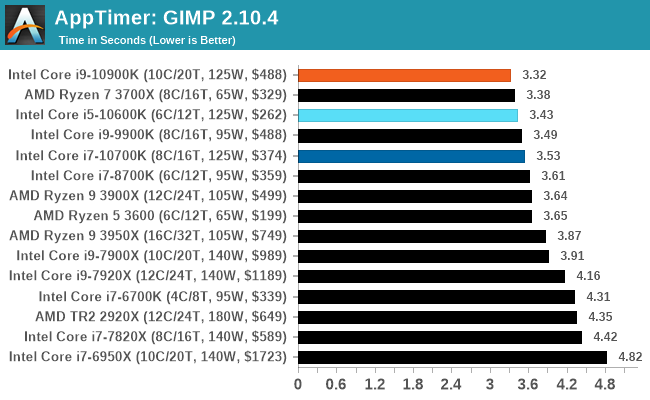
GIMP likes fast single core performance, and so the Core i9 wins here.
Agisoft Photoscan 1.3.3: 2D Image to 3D Model Conversion
One of the ISVs that we have worked with for a number of years is Agisoft, who develop software called PhotoScan that transforms a number of 2D images into a 3D model. This is an important tool in model development and archiving, and relies on a number of single threaded and multi-threaded algorithms to go from one side of the computation to the other.
In our test, we take v1.3.3 of the software with a good sized data set of 84 x 18 megapixel photos and push it through a reasonably fast variant of the algorithms, but is still more stringent than our 2017 test. We report the total time to complete the process.
Agisoft’s Photoscan website can be found here: http://www.agisoft.com/
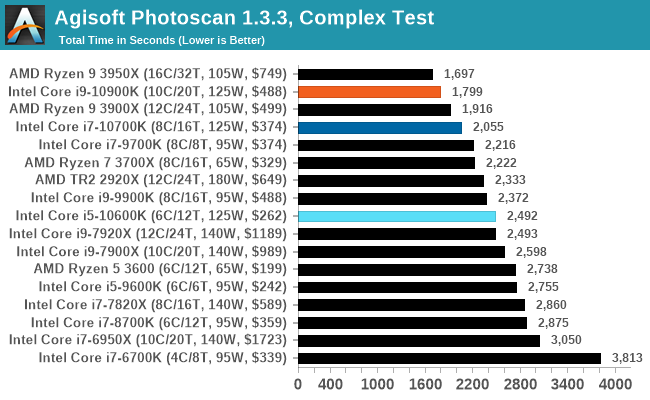
Agisoft is a mix of variable threaded workloads, so a good balanced system works best. Intel's $500 option is faster than AMD's $500 option here, with two fewer cores.
AI Benchmark
One of the longest time requests we’ve had for our benchmark suite is AI-related benchmark, and the folks over at ETH have moved their popular AI Benchmark from mobile over PC. Using Intel’s MKL and Tensorflow 2.1.0, we use version 0.1.2 of the benchmark which tests both training and inference over a variety of different models. You can read the full scope of the benchmark here.
This is one of our new tests in the database, and we are still gaining data for it.
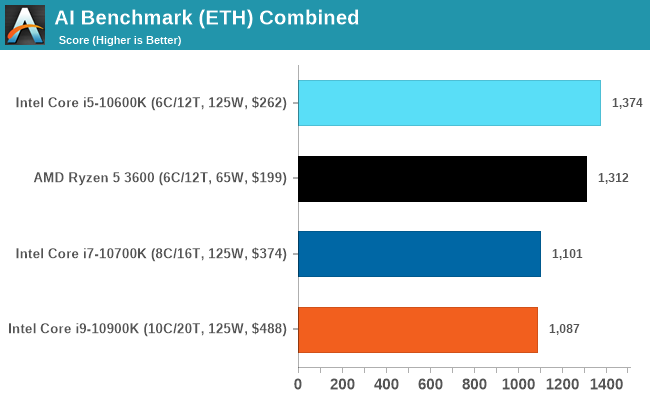
AIBench is a new test here, covering both training and inference. In the breakdown of results, we noticed that the faster processors were actually slower, scoring a lower result. We believe this is down to the lower bandwidth/core afforded by the 10c design against the 6c design.
Accelerated Science Tests
3D Particle Movement v2.1: Brownian Motion
Our 3DPM test is a custom built benchmark designed to simulate six different particle movement algorithms of points in a 3D space. The algorithms were developed as part of my PhD., and while ultimately perform best on a GPU, provide a good idea on how instruction streams are interpreted by different microarchitectures.
A key part of the algorithms is the random number generation – we use relatively fast generation which ends up implementing dependency chains in the code. The upgrade over the naïve first version of this code solved for false sharing in the caches, a major bottleneck. We are also looking at AVX2 and AVX512 versions of this benchmark for future reviews.
For this test, we run a stock particle set over the six algorithms for 20 seconds apiece, with 10 second pauses, and report the total rate of particle movement, in millions of operations (movements) per second. We have a non-AVX version and an AVX version, with the latter implementing AVX512 and AVX2 where possible.
3DPM v2.1 can be downloaded from our server: 3DPMv2.1.rar (13.0 MB)


No real surprises in our 3DPM tests.
y-Cruncher v0.7.6: Microarchitecture Optimized Compute
I’ve known about y-Cruncher for a while, as a tool to help compute various mathematical constants, but it wasn’t until I began talking with its developer, Alex Yee, a researcher from NWU and now software optimization developer, that I realized that he has optimized the software like crazy to get the best performance. Naturally, any simulation that can take 20+ days can benefit from a 1% performance increase! Alex started y-cruncher as a high-school project, but it is now at a state where Alex is keeping it up to date to take advantage of the latest instruction sets before they are even made available in hardware.
For our test we run y-cruncher v0.7.6 through all the different optimized variants of the binary, single threaded and multi-threaded, including the AVX-512 optimized binaries. The test is to calculate 250m digits of Pi, and we use the single threaded and multi-threaded versions of this test.
Users can download y-cruncher from Alex’s website: http://www.numberworld.org/y-cruncher/
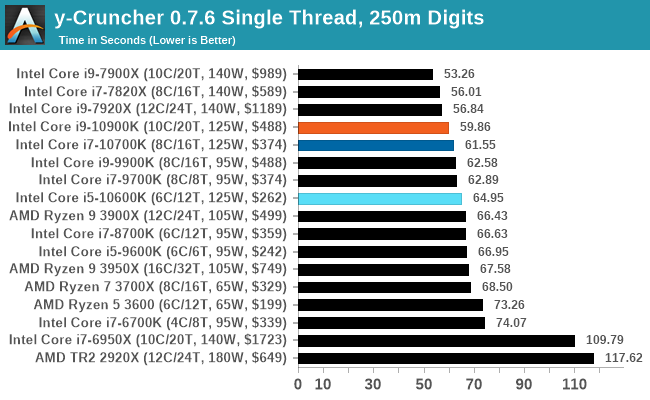
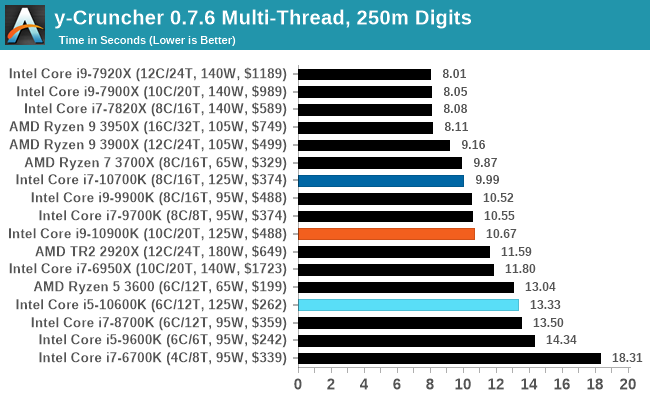
y-Cruncher is another one where the Core i9 performs worse than the Core i7 in the multithreaded test, despite being better on the single threaded test. We again put this down to memory bandwidth. We need to update this test to the latest version of y-Cruncher, which has additional optimizations for Zen 2 processors, but also to increase the digit count in our MT test.











220 Comments
View All Comments
catavalon21 - Wednesday, May 20, 2020 - link
The ability to edit (or ^Z) would be most welcome, trust me.eastcoast_pete - Wednesday, May 20, 2020 - link
Isn't that Skylake running a bit dry by now? But, seriously, Intel really risks losing a lot of market share in future years by selling these "classics" at high prices, and that is if one can get one in the first place.Curious: how many commercial customers buy Intel desktops just because they have iGPUs, but want more CPU oomph than the 3200G has? Is that why Intel still dominates the OEM desktop market?
AnarchoPrimitiv - Wednesday, May 20, 2020 - link
Intel dominates the OEM market through intimidation and threats of retribution... They were literally convicted of bribing OEMs to NOT use AMD CPUs all throughout the 2000s in several courts around the world. The trials uncovered emails between Intel executives that stated, and I quote, "Dell is the best friend money can buy".... The proof is in the fact that currently, the Ryzen 4000 mobile CPUs are the best mobile chips offered right now, but Dell only puts them in the low end laptops. Why? Because Intel is probably giving huge financial incentives to bar AMD from premium designs to perpetuate the myth that AMD isn't a premium brandRetycint - Wednesday, May 20, 2020 - link
Do keep in mind that these are baseless speculations, based on something that happened 2 decades ago. Both Intel and AMD have changed since then (new engineering team, new management etc) and there has been no evidence of Intel providing incentives to cripple AMD systems. Go take your conspiracy elsewhere.And before you inevitably accuse me of being an Intel shill, this isn't about Intel or AMD, it's about facts to support your claim, of which there have been none
Irata - Wednesday, May 20, 2020 - link
Baseless speculation? Financial horsepower, MDF and meet the comp funds are current and no secret.Why do you think there are no Ryzen 4000 laptops with GPU above a 2060?
Spunjji - Tuesday, May 26, 2020 - link
Not entirely baseless, as they made two distinct claims. I've been a party to how Intel's "Marketing Development Funds" work - and work it does, at all levels from OEM to reseller to retailer. These days they don't explicitly punish anyone for not buying AMD - they simply tie rebates that will improve the profit margins on a product to specific quantities of those products being sold. It's "nobody's fault" if those quantities happen to make the sale of an AMD product by a given retailer or reseller distinctly unlikely.As for incentivizing bad *builds* of AMD systems, though, I'm not so sure. Intel clearly do a lot of work building reference platforms, and the economics of doing integration testing for a new vendor is not trivial. Honestly though, it's hard to tell how we *would* know if this were going on, because it would absolutely be made to look innocent - just like last time.
brantron - Wednesday, May 20, 2020 - link
"literally convicted of bribing"1) No. That's not what "literally" means.
2) No. No one was even *charged* with a crime, much less convicted.
3) No. It wasn't about bribery.
The reason Athlon 64s weren't ubiquitous way back when is the same reason the 4000 APUs aren't today - there aren't enough to go around.
If your post were to be rephrased without hyperbole, baseless accusations, and whataboutism unrelated to the topic of this article, it would read something like this:
"6 months after AMD's announcement of Renoir, the number of 4000 APUs sold for desktops is literally zero (see how that works?) because TSMC is still slammed."
WaWaThreeFIVbroS - Thursday, May 21, 2020 - link
Your ignorance is amusingIt is technically a bribery
https://www.extremetech.com/computing/184323-intel...
Spunjji - Tuesday, May 26, 2020 - link
First 3 points: accurate, if not entirely on-topic. Nobody was charged with a crime, but Intel sure were fined a lot for collusion.Which gets to the 4th point: again, accurate, but not entirely relevant. AMD were definitely not able to match Intel for manufacturing, which is why they couldn't have beaten Intel out of the market entirely, but that was barely related to why they weren't getting into Dell systems. See the aforementioned proven-and-fined-for collusion.
drothgery - Friday, May 22, 2020 - link
Or because premium designs take longer when the new chip isn't just another respin of the same thing, and AMD hadn't produced a viable high-end notebook chip in well over a decade so it made sense to wait and see if Ryzen 4000 was any good rather than designing in advance?